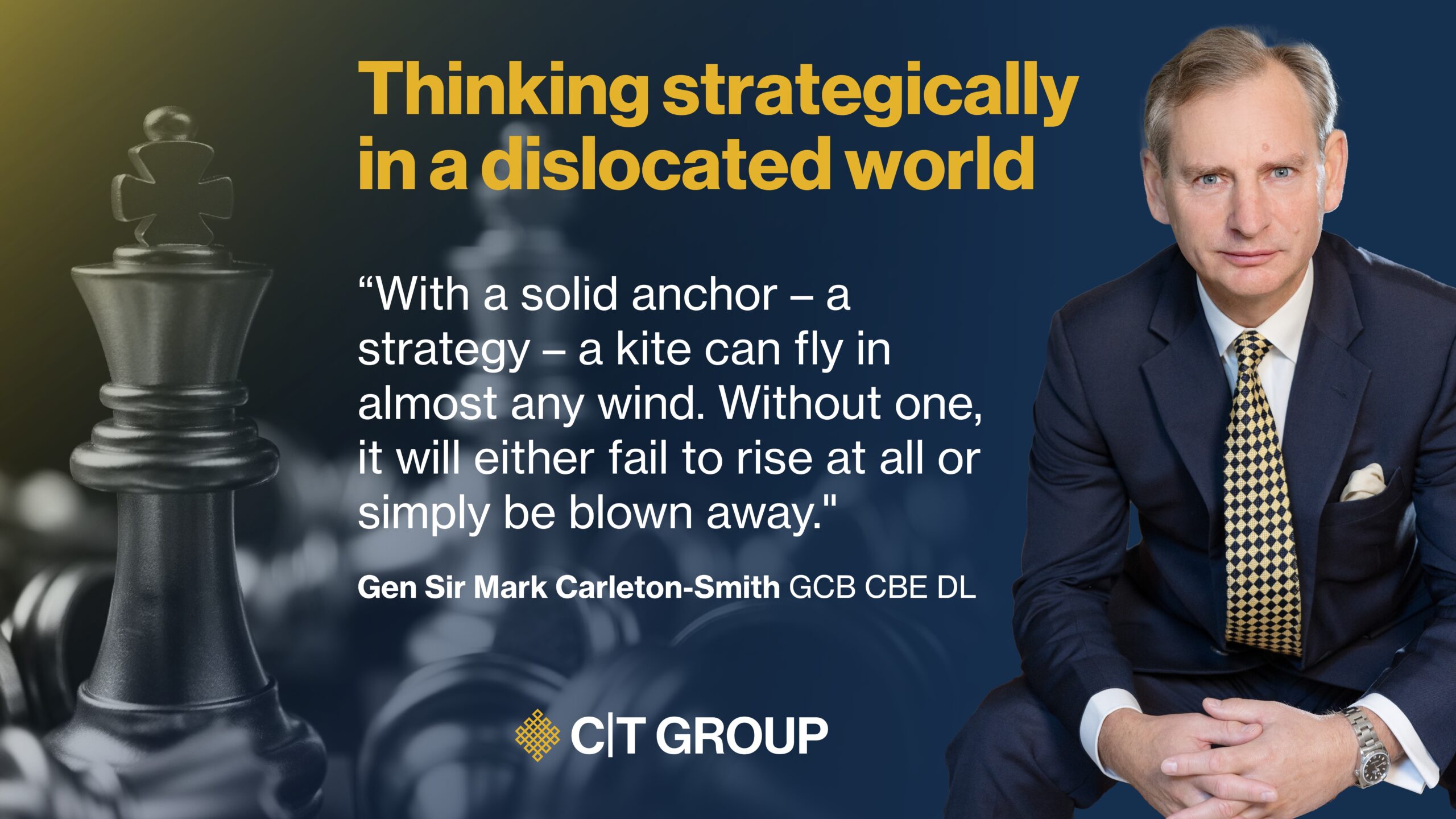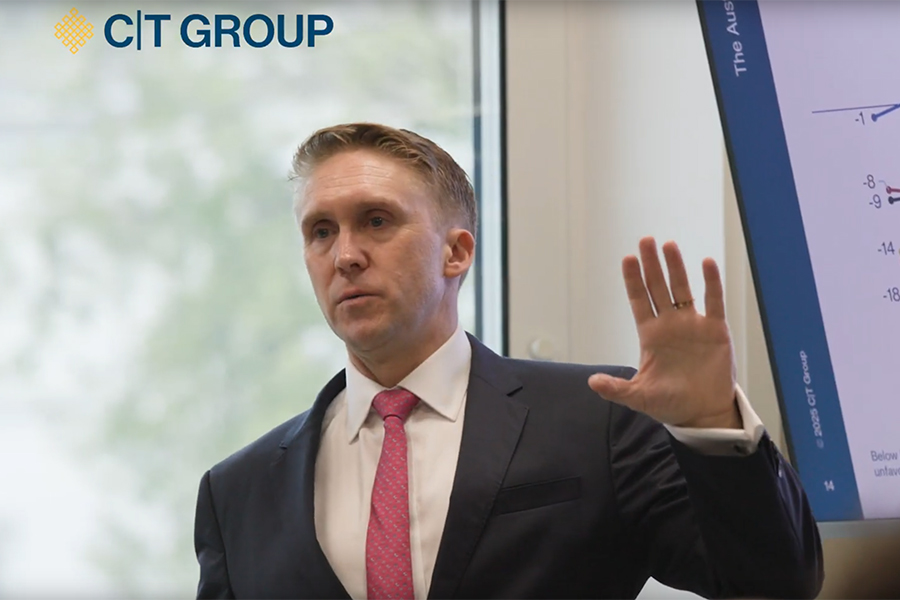Thinking strategically in a dislocated world

General Sir Mark Carleton-Smith is a senior advisor to CT Group. He is the former Head of the British Army and the longest serving Army Chief since the Second World War. During a 40-year career, Mark served across the Middle East, the Balkans, South-East Asia, Africa, Afghanistan and South America. He has commanded the SAS and is the first Director Special Forces to be appointed as the Chief of the General Staff.
In this series of 3 articles, Mark explores various aspects of leadership and decision making at the very highest levels including the challenges faced by any organisation looking to survive and thrive in complex, volatile geopolitical conditions.
Thinking strategically in a dislocated world
Read time: 5 minutes
‘Strong men are made by opposition; like kites they go up against the wind.’ Frank Harris
There’s been a grave, persistent error at the heart of the West’s strategic thinking for over thirty years. It’s an error from which business leaders as well as political and military strategists must learn, and one from which they can profit, too.
The error is this: that a kite needs only wind in order to fly.
As the immediate and existential threat from the Soviet Union abated, the West’s figurative kite was becalmed. Without the prevailing wind of Soviet ideology to go up against, it fell to the ground. The mistake we made was in letting go of the string.
With a solid anchor – a strategy – a kite can fly in almost any wind. Without one, it will either fail to rise at all or simply be blown away.
To bring this analogy back to earth: when the Soviet Union collapsed, Western leaders and commentators saw it as a conclusive victory of inherently superior liberal-democratic values instead of what it was: a contingent triumph of liberal-democratic values anchored by a determined and consistent pursuit of strategic interests.
This confusion of interests with values lies at the heart of what David Richards and Julian Lindley-French have recently dubbed ‘ Western leaders, in abandoning strategic aims, also lost the habit of strategic thinking. We saw this in Afghanistan and we’re still seeing it in relation to Ukraine. The West remains long on expressions of moral intent but woefully short on practical strategy.
The lessons that apply to political and military strategic thinking apply equally to commercial enterprises
We need not look far to learn what poor or non-existent strategy looks like in a commercial context. We have – perhaps most famously – the examples of Kodak or Xerox. Or we might consider how Blockbuster’s leadership laughed the Netflix founders out of the room when offered the start-up for $50 million. It’s tempting to focus on Blockbuster’s failure to foresee that said start-up would one day be worth $300 billion. This would be a mistake. Blockbuster’s shortsightedness is only remarkable in retrospect and, more importantly, in contrast to the extraordinary scope, scale and clarity of Netflix’s strategic vision: ‘to entertain the world.’
Consider, too, how Amazon has maintained its admirably simple but superbly flexible strategic priority of being ‘Earth’s most customer-centric company’. This unwavering focus has allowed the company to expand into diverse areas while maintaining a consistent, coherent strategy throughout its evolution from online bookstore to a global e-commerce and cloud computing colossus.
We should be wary of ascribing successful strategies to individuals. Nor should the failures be chalked up to blindness or stupidity of specific leaders. Highly intelligent, highly experienced people make mistakes, after all.
Instead, we should recognise that these respective successes and failures were down to a combination of factors ranging from luck, ability and courage to whether or not the organisations had an effective strategic brain.
Why the selection and maintenance of the primary strategic priority is so important – and so difficult
Whether you’re leading a country, engaged in conflict or running a company, setting the primary strategic priority is the first order of business for the strategic brain.
It is a difficult, time-consuming and often patience-testing process, but an essential one. If an organisation’s strategic aim is not realistic, well-defined and clearly articulated, it is impossible for leaders to identify the necessary ways and means to achieve the aim.
Equally important, a clear strategic aim acts as a benchmark against which to measure success or progress. Without one, leaders will fall into that oft-cited trap of measuring a company’s performance (and their own) against metrics like market cap, market share or shareholder return. It is more challenging but also more important to measure its progress towards achieving an aim – an aim that is more likely to be qualitative than quantitative.
This is why an organisation’s strategic brain must boast a range of attributes far beyond the cold, formal skills required for planning or analysis. It must keep short-term and long-term aims in focus simultaneously, accommodate competing interests, and reconcile conflicting views.
Above all, the strategic brain must enable leaders to make swift, high-stakes decisions in opaque, ambiguous circumstances, even when those decisions aren’t supported by the available data or run counter to accepted wisdom.
The importance of outside perspectives
If the selection of the strategic priority weren’t difficult enough, there’s the question of maintaining it. Again, this is where the strategic brain must exhibit uniquely human attributes like intuition and sound judgement so that leaders can prioritise the essential over the merely desirable and distinguish emerging trends from the underlying causes of those trends.
The strategic brain must therefore draw on as wide a range of skills, ideas and experience as possible. This is why the most effective presidents and boards so often look for advice beyond politics or sector-specific experience respectively. They know that outsiders are often uniquely placed to help leaders identify, nurture and exploit their organisation’s asymmetric advantage.
Successful leaders also tend to lean on outside advisors with whom they are likely to disagree. The value of these outsiders lies not just in what they know or what they think; it’s how they think that matters most. This is true whether they’re helping officers and board members define their strategy or adjust their tactics. It’s also true when they’re helping leaders transform an organisation so that it might withstand or profit from strategic change – or even initiate it.
In the long term, successful organisations, like successful leaders, benefit from being challenged. They rise against the wind, it’s true – but only because they’re strategically tethered.
The CT Group combines expertise in intelligence, research, campaigns, and advice to deliver winning campaigns globally. With decades of experience, offices around the world, alongside a team of international, multilingual staff, CT Group’s offering underlines the importance of clear information and focused strategies to achieve results.
For more information, please contact us.


